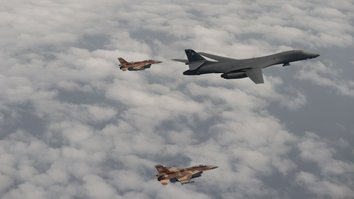The ability of US B-52 Stratofortress bombers to be equipped with long-range cruise missiles represents a game-changing option for overrunning the air defences of an adversary while hitting high-value targets from long range at the same time.
The Stratofortress is a long-range, heavy bomber that can perform a variety of missions, including strategic attack, close-air support, air interdiction, offensive counter-air and maritime operations, according to the Air Force.
It can carry a multitude of various ordnance, including precision-guided weapons such as the Joint Air-to-Surface Standoff Missile (JASSM), a low-observable standoff air-launched cruise missile.
The missile can be used to strike a wide range of targets, including command and control centres, air defence systems, communication facilities, and high-value infrastructure targets such as power plants and bridges.
![A US Air Force B-52 Stratofortress supports a mission in the Indo-Pacific region on April 16. [US Air Force]](/cnmi_ca/images/2023/04/21/41790-b-52-585_329.jpg)
A US Air Force B-52 Stratofortress supports a mission in the Indo-Pacific region on April 16. [US Air Force]
One of the key advantages of the JASSM is its standoff capability, which allows it to strike targets from a safe distance without exposing the launching aircraft to enemy defences.
The original version of the JASSM has a range of 370km, while the JASSM-ER (Extended Range) has a range of approximately 1,000km, according to the Centre for Strategic and International Studies Missile Defence Project.
Equipped with 432kg warheads, the JASSM is designed to be highly survivable, with stealth features that reduce its radar cross-section and make it difficult to detect and track.
The missile also has a low-altitude, terrain-following capability that allows it to fly at very low altitudes and avoid detection by enemy radar systems.
The JASSM has a dual-mode guidance system that allows it to navigate through global positioning system (GPS) and an IR seeker. The guidance GPS provides mid-course guidance, while the IR seeker provides terminal guidance, allowing the missile to strike the target with great accuracy even in adverse weather conditions or when the target is obscured by smoke or debris.
The JASSM-ER when equipped with a weapon data link can correct course after launch, enabling it to hit moving targets on land or at sea.
Deliveries to the Air Force of another variant of the missile, the JASSM-XR (Extreme Range) with a range of approximately 1,800km, are expected to begin in January 2024.
Each Stratofortress can carry up to 12 JASSMs on its wing pylons and another eight inside its bomb bay.
With 20 B-52Hs, or less than half the active fleet of 58, the US Air Force could deliver some 400 JASSM-ERs against targets from a maximum stand-off distance of 1,000km.
Evading enemy defences
Over the years, the B-52 has undergone numerous upgrades and modifications to keep pace with evolving threats and technologies, including new engines, a new radar and advanced air defence systems.
Once they receive their new Rolls Royce F130 engines, B-52Hs will become B-52Js, according to the Air Force's fiscal 2024 budget documents.
Meanwhile, the new radar will be a variant of the Raytheon AN/APG-79, an active, electronically scanned array (AESA) radar used on the Navy's F/A-18 Super Hornet fighter, Air and Space Forces Magazine reported on April 5.
The Air Force expects B-52Js with both new engines and new radars to be available for operational use by 2030.
While the B-52 is not a stealth aircraft, it has a number of features and tactics that allow it to evade or overrun enemy air defence systems.
Two of the key capabilities of the B-52 are its speed and altitude. The B-52 is capable of flying at high altitudes, more than 15,000 metres, which makes it difficult for most ground-based air defence systems to track and engage.
Additionally, the B-52 can fly at high speeds, more than 1,000km per hour, which allows it to quickly penetrate enemy airspace and minimise its exposure to air defence systems.
The B-52 is also equipped with advanced defensive systems, such as electronic countermeasures (ECM) and chaff and flare dispensers.
ECM systems emit jamming signals that disrupt enemy radar and communication systems, making it difficult for air defence systems to accurately track the B-52.
Chaff and flare dispensers release clouds of metallic foil and heat-emitting flares that can confuse and decoy enemy missiles.
Another tactic used by the B-52 is to fly in formations with other aircraft, such as fighter jets and electronic warfare aircraft. This tactic, known as a "strike package", allows the B-52 to benefit from the protection of other aircraft and increase the overall effectiveness of the mission.
Fighter jets can engage enemy fighters and air defence systems, while electronic warfare aircraft can jam enemy radar and communication systems.
B-52s have an unrefuelled combat range in excess of 14,100km.

![A US Air Force B-52H Stratofortress assigned to the 5th Bomb Wing is prepared for loading of air-launched cruise missiles during Global Thunder 23 at Minot Air Force Base in North Dakota April 12. [US Air Force]](/cnmi_ca/images/2023/04/21/41789-b52-cruise-missile-585_329.jpg)







USA! Give Ukraine long-range missiles! And the war will end soon!!! What are you waiting for??? Or KILL DCK...HEAD, the maniacal murderer!!! GLORY TO UKRAINE!!!
Reply1 Comment(s)